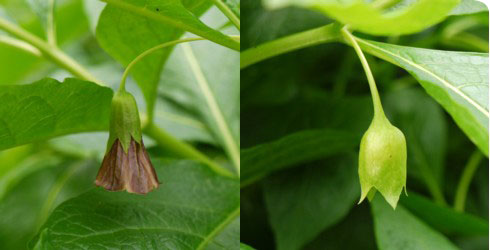Biology
Scopolia carniolica is a perennial herb forming an underground horizontal rhizome from which every spring, masses of shoots sprout to form a structure resembling a small bush. It has a maximum height of 60cm.
It has simple, elliptical leaves - 10–20cm long and 3–8cm wide. The leaves are entire or have slightly toothed edges and are arranged alternately along stout and somewhat branched stems.
Solitary flowers hang from the leaf axils on slender pedicels. The campanulate - bell-shaped - calyx has 5 shallow lobes and significantly enlarges after pollination to enclose the fruit.
The cylindrical to campanulate corolla is also shallowly angled and 5-lobed at the top, and ranges in colour from brownish to deep purple. A rare yellowish-green flowered variety from Slovenia is sometimes separated into its own species as Scopolia hladnikiana Fleischm. ex Nyman.
Five - rarely more - stamens are inserted at the base of the corolla tube and alternate with its lobes. Ovoid anthers open by a longitudinal split.
The superior ovary is topped by a simple style ending with a capitate (head-like) stigma.
Fruit takes the form of a spherical capsule about 1cm in diameter and when mature opens along its circumference with the top coming off as a lid. Numerous seeds are kidney shaped and about 2.5mm long.
Reproduction
In its natural habitat Scopolia carniolica reproduces mainly by rhizome fragmentation - the most effective way to cover a large area in a short time.
In March, flowers occur and sexual reproduction proceeds. These flowers are formed on the rhizome the previous autumn and after winter they open very quickly to ensure pollination in the short alpine spring.
Individual flowers stay open for 5 to 8 days and are pollinated by bees. The flowering period lasts about 4 weeks.
Seeds are released throughout April and May and are dispersed by ants.
Germination starts in June. Seedlings stay in the juvenile period for about 5 years when they concentrate most of their energy on the growth of the underground rhizome. After that period the first flowers appear.
Some authors report that in Scopolia carniolica seeds may also be formed as a result of so called ‘adventitious polyembryony’. This is an interesting process by which maternal cells in the ovule divide mitotically - without fertilisation - producing embryos that compete with the sexually produced embryo. However, in Scopolia these additional embryos never fully develop and degenerate quickly.
Toolbox
Glossary
Calyx
Group of sepals.
Corolla
Group of petals.
Ovules
Structures that develop into seeds when fertilised.
Parasympathetic
Part of the nervous system that regulates muscle contraction.
Relict species
Species that were formerly widespread but now only occupy small areas.
Rhizome
Underground stem of a plant.
